We had a “wicked problem” on our hands when Hurricane Sandy struck the US eastern seaboard on October 29th, 2012. Sandy was dramatic, destroying 72,000 homes, causing tens of billions of dollars in infrastructural damage, displacing thousands of residents (many of whom are still displaced), and completely disrupting one of the largest regional economies in the world. However, the wicked problem Sandy posed for New York City (NYC) was not the magnitude of the storm damage or any particular local disaster. The wickedness of the problem lay in exposing the sensitivity and vulnerability of the complex social-ecological system of NYC, where a single storm event simultaneously decimated multiple components (and connections between components) of the city system.

How best to get clean water, food and shelter to the thousands of affected residents of New York and New Jersey when roads were flooded or washed away, when food and fuel distribution centers were out of power and regional transportation was effectively cut-off, when people couldn’t even make a cell phone call to report they were in need? The fact is there was no perfect solution to the problem of what to do after Sandy struck, because that is the nature of wicked problems, you only really understand the nature of the problem after you’ve started working on the solution, which is to say, after you have gotten your hands dirty trying to fix it. This is not the way we typically think of problem solving, and it’s why Sandy was difficult to respond to.

Responses to Sandy didn’t just call for, but required systems thinking. Ecologists have been thinking in systems since Arthur Tansley first used the term “ecosystem” in print in 1935. The Odum brothers (Eugene and Howard) pioneered systems approaches in ecology in the 1950s and 60s. More recently the emerging field of urban ecology, which explicitly includes humans as fundamental components of systems, has taken a social-ecological systems approach to the study of cities. Cities like New York are the classic example of a complex social-ecological system and systems thinking remains one of most useful tools to understand cities. In this post I illustrate a couple case studies of how systems thinking can provide useful tools for both understanding the structure of complex systems like cities, and dealing with wicked problems.
Wicked Problems
It turns out that the nature of cities is one of fundamental system complexity, and this complexity can be wicked to understand, wicked to manage. Sandy was a wicked problem. Wicked problems are those that have multiple interacting systems — social, ecological, and economic — a number of social and institutional uncertainties, and imperfect knowledge, all of which apply to the state of the New York megacity immediately following Sandy. Wicked problems are not easy to solve because it is impossible to define and describe their full nature. Additionally, wicked problems are continually evolving. For example, when Sandy struck New York electrical power was knocked out regionally for millions of residents by high winds and flooding, yet those with generators for their homes or businesses were not initially too worried, that is, not until the gas lines became increasingly long and fuel availability to power generators eventually went to zero. At this point, only a couple days later, the problem initially posed by high winds and flooding had already evolved into a myriad of new problems, including how to provide liquid fuel to residents who needed it for heat as the weather began to turn cold. What required solutions on day 1 after Sandy was very different in many places from the problems arising on day 4 and 5. As a consequence, no single or definitive optimal policy solution to the wicked problem of Sandy could satisfy all the affected parties. There was no perfect governance decision for a mayor or governor to make.
The man who coined the term ‘wicked problem’, urban planner and designer Horst Rittel, perceived the limitations of the linear ‘systems approach’ of design and planning over 30 years ago. Rittel and his colleagues’ provided a foundation for what Rittel termed a ‘second generation’ of systems analysis because he found traditional planning methods inadequate for the ill-structured problems he encountered in city planning. One of the fundamental problems with solving wicked problems is lack of information, or lack of transparency and availability of information since social and infrastructural complexity creates barriers to information sharing.
During the aftermath of Sandy, one of the critical issues at the heart of helping survivors in the hardest hit areas was information about their actual needs. Scientists like to address these problems by creating new sources of information, but if the information is not able to flow easily to where it is needed for decision-making, what use is it? Social complexity can cause fragmentation in the system that makes problem solving difficult or worse, impossible. Fragmentation in information availability is a serious source of the wickedness in urban problems.
One thing we are learning from Sandy in New York, but likely true in cities in general, is that because of social complexity, solving a wicked problem may fundamentally be a social process. Having a few brilliant people or the latest project management technology is no longer sufficient. As Russell Ackoff, operations theorist, puts it:
“Managers are not confronted with problems that are independent of each other, but with dynamic situations that consist of complex systems of changing problems that interact with each other… Managers do not solve problems, they manage messes.”
Systems thinking and the social-ecological systems of cities
Systems thinking is a way of understanding the world, a worldview, a process of organizing information in order to understand its complexity. But it is not the only way of organizing information and is contrasted with linear and non-linear thinking, much more common modes of understanding. Ecologists and social scientists have taken advantage of systems thinking for decades to better understand complex systems from ecosystems to organizational systems to cities. This includes understanding how systems respond to external perturbations, whether it’s a hurricane or economic recession, and what fundamental structures and functions are critical for resilience and sustainability.
Interconnectedness is a fundamental trait of systems and cities as examples cannot then be understood or effectively managed by focusing only on a subset of system components. All social-ecological systems are marked by interconnectedness. Importantly, connectivity is within and between the ecological and social components. Indeed, the hallmark of system thinking is that it focuses on the connections and relationships, more than the components themselves.
Systems thinking is crucial to problem solving including for urban planning and policy, because no problem exists in isolation, all are part of a larger system of interacting networks; social networks, biogeophysical networks, political networks, and economic networks. Interestingly, it turns out that you can’t understand the behavior of system by studying its parts; you need to study the whole thing. Which poses perhaps a series of wicked problems for urban planners.
Jay W. Forrester was an early architect of systems thinking. As he puts it:
“Systems of information-feedback control are fundamental to all life and human endeavor, from the slow pace of biological evolution to the launching of the latest space satellite… Everything we do as individuals, as an industry, or as a society is done in the context of an information-feedback system.”
Systems thinking must play an integral role in how we think about the nature of cities. The concept of ecosystems is a cornerstone of twenty-first century science and urban ecology theory can be traced back to systems thinkers who provided much of the intellectual foundation for organizational theory. Despite the applicability of system thinking to natural resource management, we are constrained in our ability to think in systems. For example, virtually all natural resource managers have some formal university education, which nearly always includes traditional philosophy based on ideas of reductionism developed by Descartes. We all “know” that the way to solve difficult problems is to break them into their component parts and solve each part in isolation. This approach is ingrained in education and scientific knowledge. However, the implications are largely unrecognized.
Systems thinking starts by questioning the Cartesian assumption that a component part is the same when separated out as it is when part of the whole. In social-ecological systems, it is fair to say that we now know this assumption is wrong. The behavior of a component depends fundamentally on its relationship with other components in the system (and on their relationships with still other components). This is true of genes in genetic networks, it’s true of human behavior in social networks, and true of businesses in economic networks. Urban ecologists have applied this approach for over a decade, but the application of interdependence of system components has still not been well enough understood to change the way we problem solve in complex systems such as cities.
Is the problem of hurricane-driven storm surge fundamentally a flooding problem? Is there anything a priori particularly wrong with flooding? Or rather, is flooding instead a problem because it is connected to issues of energy supply, economic productivity, food security, drinking water availability, transportation, and energy supply. To solve flooding problems in highly interconnected social-ecological systems requires not only thinking about hydrology, but also about the relation of flood prone areas of the city to transportation networks (subway tunnels in NYC are prone to flooding in many areas), population density (in flood risk zones), building height (elderly living on high floors were more at risk in power outages caused by Sandy), electric cable routes (are cables underground?), backup energy supply for cell phone towers (when power goes out, so does other infrastructural functioning), and food distribution (how does flooding affect equity of food provisioning?). Luckily for New Yorkers, planners, engineers, and scientists are continually expanding our understanding of connectivity and feedbacks between components of our urban system.
Components or variables in systems undergo change, but the rate of change varies. Some variables may change quickly, others slowly. Understanding slow and fast variables is critical to understanding how changes in one part of the system may affect other areas. Slow changing variables can be problems when trying to alter the system, such as making it more resilient or more sustainable. For example, policy is slow to change, because it is part of a system that tends to reinforce itself. A systems thinker will not be surprised that changes to policy are slow, whether at the neighborhood, city, or state scale.
Once you start thinking in systems, you realize the fundamental interconnectedness of all aspects, from residents’ political opinions and therefore what leaders they choose, to the number of acres of wetlands remaining in the NY-NJ harbor and their ability to absorb storm surges. Sandy’s impact underscored the importance of a systems oriented approach to planning our way toward climate change resilience in NYC. Just as Sandy was not an isolated incident, but part of a larger regional and global climate system that produces weather, including very rare hurricane events, the effects of Sandy on the city were also not isolated, but driven by the interwoven social, ecological, and economic infrastructure of the city. The variation in each system component across the city allowed some areas to be more resilient to the storm than others. Most of the hardest hit areas were low lying and directly affected by storm surges which produced major flooding, but the larger scale effects were not only driven by flooding, but a combination of infrastructure, timing, social networks or lack thereof, energy supply, and, as is the nature of complex city systems, many, many other components.
Resilience
Can systems thinking enable us to design, build, and renovate cities to be more resilient? Since we live in an era of rapid change, including urbanization, population growth, and climate change, we have the challenge of rapid and flexible response at all levels. Resilience theory is one of the major conceptual tools we have to deal with change at multiple levels of organization, from local to global. In social–ecological systems theory, resilience is the capacity of the system to continually change and adapt and yet remain within critical thresholds.
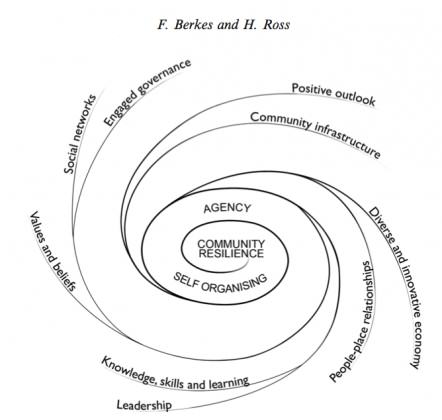
Resilience is a systems concept, and the social–ecological system, as an integrated and interdependent unit, may itself be considered a complex adaptive system (Norberg and Cumming 2008). As such, the analysis of community or urban resilience will likely be sensitive to the various principles of complexity ins systems, such as feedbacks, nonlinearity, unpredictability, and scale.
Resilience theory inherently deals with system dynamics and envisions ecosystems as continuously changing, sometimes abruptly and unpredictably. In its broader context, resilience is about ecosystems and people together as integrated social–ecological systems in which social systems and ecosystems are recognized as coupled, interdependent, and coevolving. As Fikret Berkes and Helen Ross suggest in their recent paper, applying systems thinking can help us move towards a better basis for sustainable development, one where adaptive governance is driven by a social-ecological systems approach towards resilience.
Below I describe two urban case studies to illustrate the utility of system thinking for dealing with wicked problems and understanding the complex nature of cities.
Two Urban Case Studies
Environmental Studies students at The New School have been practicing systems thinking in my Urban Ecosystems course since 2009. They spend a full semester conducting extensive research on a city of their choice from a social-ecological systems perspective, focusing on a particular issue (e.g. stormwater, pollution, food security, drinking water, biodiversity). Students immerse themselves in systems theory and the latest urban ecology research, and then practice thinking in systems by creating a systems diagram that describes the relationships among major variables connected to the particular issue under study in their city. Below are two case studies from the fall 2012 course illustrating how systems thinking can provide insight into complicated social-ecological issues and point towards new opportunities for improving resilience and sustainability in the city.
Environmental Health in Greenpoint, Brooklyn
Let’s start with the issue of pollution in NYC. The waterways around the city have historically been very polluted, in the past receiving the lowest possible EPA water quality rating in much of the harbor and surrounding areas. Pollution levels have been overall largely reversed in recent years due to significant focus by the city to cleanup contaminated aquatic habitats, with fecal coliform bacteria now below levels determined safe for swimming in many areas, including in the Hudson river.
Still, three water bodies in NYC have been declared federal Superfund sites, including 200 river miles of the Hudson River. There are seven more Superfund sites within the five boroughs alone, including the Gowanus Canal, Newtown Creek, three land sites in Queens, and two land sites on Staten Island. Newtown Creek in particular is one of the most polluted waterways in the US and is home to contaminants such as PCBs, VOCs, pesticides, and heavy metals, due to countless spills and leaks from industrial production along the creek, including from over 50 oil refineries, coal yards, petrochemical plants, and glue factories, some of which are still in operation today.
Greenpoint, Brooklyn, a neighborhood with intense levels of pollution, was the focus of a study by New School student Alex Dolan. Greenpoint has the largest proportion of industrial land in NYC, is home to multiple sources of current and historic pollution including the Newtown Creek wastewater treatment plant, a radioactive storage facility, 30 extremely hazardous waste storage facilities, 17 petroleum storage facilities, and 96 above ground oil storage tanks. Added to this is the infamous Greenpoint oil spill consisting of 30 million gallons of oil spilled over 100 acres, equal to three times the volume of the Exxon Valdez spill, which leaked oil into soils and groundwater in the surrounding area.
When considering the spill from a systems perspective, Dolan realized the combined effect is not simply polluted water, but the pollution of a complex, interdependent social-ecological system.

There are several different flows of pollutants that degrade aquatic environments in NYC, reducing aquatic biodiversity and adversely affecting human health. In Dolan’s diagram pollutants flow from the economic system, where industry and businesses provide services and products to other industries and businesses, as well as the residential sector, which both directly creates waste and leads to other waste generation by the second tier of users. From the economy, pollutants spread into many parts of the biosphere, here specifically to New York Harbor. Pollutants are added to the harbor as they flow downstream from upstream sources, including via landfill leachate and through storm water runoff from city streets, which combines in sewer overflows when it rains. Pollutants also reach the water through atmospheric deposition, which deposits particulates including laden with metals, and through the continuous burial and resuspension of sediment, which can carry PCB’s and heavy metals.
Once pollutants reach New York area waters, some degrade the aquatic environment so that only the most tolerant species remain. Ultimately, persistent pollutants taken up by aquatic organisms bioaccumulate in the food web. PCB’s work in this way and though their production was outlawed decades ago, they remain persistent in New York and many other waterways. Certain species are more likely to contain PCB’s and other bioaccumulating substances and are therefore more dangerous to consume than others due to their specific habitat location and diet. Even the safest category of fish (except Bluefish) caught in New York Harbor and surrounding waters are only deemed safe enough to eat 4 times per month, and then only by males over 15 and females over 50.
Contaminated fished are caught and eaten as an important source of food in Greenpoint homes, and pollutants move from the ecological system to the social system of Greenpoint residents. Here, 35.7% of residents live below the poverty line with median household income only $16,409 ($10,000 below the Brooklyn mean), contributing to a high proportion of families relying on local fishing as a source of food security. In a recent study by the EPA, anglers were either Latino or African American and almost all were male between the ages of 16 and 60. All the anglers interviewed said they were providing food for at least one family member under the age of 19. Anglers in these neighborhoods were catching between 40 and 75 fish per week, and each family member (including children) was eating an average of 9.5 fish per week, sometimes two fish meals per day. Those interviewed expressed the need to feed their families in an environment that was hard to find work in, and that fishing also provided an important link to traditional life. The four species most frequently caught by Greenpoint residents were blue crab, American eel, bluefish, and striped bass, all of which are listed on New York State fish advisories.
To better understand why Greenpoint residents consume contaminated fish even though advisories and posted signs around the city warn against consumption, Alex created a second systems diagram to map the relationships within the angler system. In interviews Greenpoint anglers mention that they often have trouble finding work and that fishing is the only way they can reliably provide food for their family. In the preliminary systems analysis, it became clear that social complexity in this system is highly connected to Greenpoint residents’ status as an at-risk population. In the systems diagram, Alex has identified a reciprocal relationship of influence on the environmental health of the community with strong influence by cultural norms and income, and with flows of pollutants, information, capital, and social connectedness all influencing patterns of fish consumption and their effects on community health.
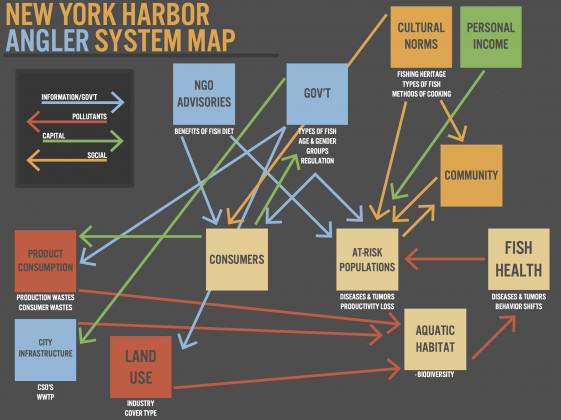
One can initially ask why government has not been particular effective in terms of influencing local residents to eat less contaminated fish, and the systems analysis helps shed light on this problem. In this case, systems thinking does not automatically point to solutions. Rather, it is a tool for better understanding the problem, perhaps even providing a more clear statement of what the problem is, or how it is evolving.
It turns out that signage in fishing areas often warns of the dangers of fishing in English, whereas most of the anglers are non-English speaking. Possible points of intervention in this social-ecological system may need to better recognize cultural norms and the power income has over food availability, while still recognizing the ecosystem service fishing provides to food security. Clearly, social, cultural, political, economic, and ecological systems are all at play in influencing the health of New York Harbor and the New Yorkers who rely on it for their livelihood.
New York City Watershed and Sandy
Stephanie Valencia, another student in my fall 2012 Urban Ecosystems course, took up the issue of flooding in New York, with a focus on understanding how hurricanes like Sandy affect the hydrology of the system and result in damaging flooding effects on area residents and infrastructure. First she realized she needed to understand the water infrastructure, including the organization of the drinking water supply for NYC.

Credit: Stephanie Valencia
To understand how hurricanes influence flooding in NYC, Valencia needed to also understand how water moves in a tropical storm system and comes ashore to cause storm surge. In the second diagram she maps the primary drivers influencing tropical storm development as warm ocean water, winds, and warm moist air create positive feedbacks with the humidity and evaporation until the cycle on the top of diagram is created leading to a tropical storm or hurricane. When the hurricane encounters the coast, the system changes to interact with land creating storm surges, also affected by tide and wind patterns.

Valencia’s effort at applying a systems approach to understanding Hurricane Sandy led her to diagram how storm surge generated at point 2 above leads into the social-ecological system of the city in point 3 (diagram below). Here, storm surge causes infrastructural damage that in turn causes nearly all city-wide organizations in the social system to mobilize to respond to the problem of Sandy, here defined narrowly as the problem of flooding. The infrastructural damage leads to damage of residential homes including home flooding, sewage backup, plumbing, and roof leaks causing residents to be homeless. This is damage is viewed as an input to the residential home subsystem where pollution, organic nutrients, viruses, debris, and toxicity are effects. The effects on the residential home system drives organizations to allocate resources, funds and volunteers to create alternative methods to combat the complex interactions within the system driving gas shortages and impacts on public transportation. Alternatives like bus shuttles, biking, car sharing, and free generator power were created in order to bring relief to highly impacted areas. These alternatives served to improve social cohesion and collaboration toward mass recovery.

Credit: Stephanie Valencia
A fourth diagram (below) illustrates how CSOs in NYC during wet weather flow (WWF) contribute to the flooding problem with affects on aquatic ecosystem and drinking water, which in turn has effects on the social system through drinking water contamination, fishing and recreation restrictions, and biodiversity loss.

Clearly, there are many aspects of the system that are not included in Stephanie’s system diagrams, and that is the point. To really describe the state of a complex system like a city, we need to think from a systems perspective intuitively and recognize the vast complexity involving hundreds and thousands of interconnected, interacting variables. The second point is to illustrate as Stephanie has done, that we can temporarily break the system into subsystems to begin the description process that may ultimately lead to improved understanding of where the points of leverage are for intervening in the social-ecological system to increase resilience to the next disturbance.
In Stephanie’s final diagram she focused on how one particular community organization, the Rockaway Waterfront Alliance (RWA), responded to Sandy as a small subset of the larger social system. The idea here is to understand how one can slowly begin building up an understanding of the larger social-ecological system of the city by understanding particular components, such as the social organization RWA, and how it shifted their service model in the wake of Sandy to organize, support, mediate, fund, and gather and organize resources, and volunteers.
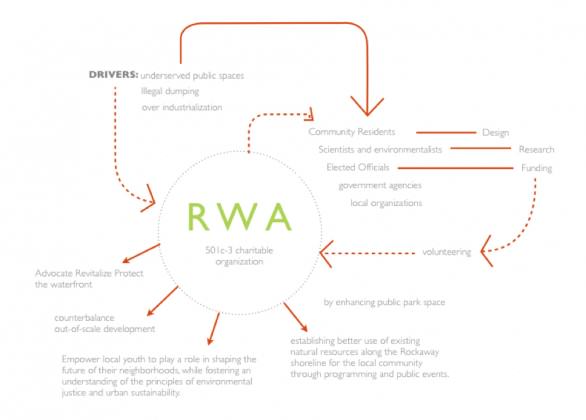
Systems Thinking and Wicked Problems
Noted ecologist Kevin Gaston, in his edited book, Urban Ecology, notes that urban environmental management poses a classic wicked problem, one where there is no obvious solution and the complexity of the system makes it extremely difficult to find out in advance if a proposed solution will improve resilience and sustainability or ultimately make matters worse. For example, installing tidal barriers around New York City could alleviate the problem of storm surge, but they may also simultaneously affect the harbor economy and lead to environment impacts in the harbor in difficult to predict ways. System thinking helps us understand what is difficult to predict, which is important when urban planners and policymakers are analyzing the costs, benefits, and short and long-term effects of design interventions for improving resilience to Sandy-like events.
Sandy is now long over, and many of the effects are no longer visible in the less impacted areas of the city. But rebuilding, designing, and planning a future NYC to be more resilient to future Sandy-like disturbances remains a challenge. Dealing with future urban disturbances means rebuilding the most affected areas to be resilient to hurricanes and also other significant disturbances, but which components of the system are most important to address to achieve resilience?
For example, NYC is very focused on buildings and water. Clearly we need to find better ways to deal with storm surge, given the fact that NYC is low lying. If sea levels rise four feet by the 2080s as predicted then 34 percent of the city’s streets could lie in the flood-risk zone, compared with just 11 percent now. On the other hand, if infrastructural solutions are not well understood in the context of the complex social-ecological system, then resilience could just as easily decrease.
Can wicked problems be solved?
Donna Meadows, one of the early pioneers of systems thinking, notes that there are, of course, complex problems that may have no solution. Systems thinking is not in itself a solution to wicked problems, but a method for highlighting areas of intervention that can lead to potential solutions or ways to improve the resilience and sustainability of a complex system. However, in the era of Big Data the ability to understand the nature of cities as complex systems has gotten a boost with now massive amounts of data about fundamental components, which means we should, in theory, be better able to understand the relationship among components. Take for instance New York City as a system. We now have high-resolution spatially explicit data of all kinds. Real-time social networking data from New Yorkers can also be downloaded and analyzed from Twitter, Facebook, Instagram, and Foursquare. Local census data provides social demographic data while land use, land cover, soil data, and other biophysical data are increasingly available at high resolution. The list goes on. In my last post I illustrated how combining big data with a social-ecological systems approach can open new opportunities for urban transformations. I examined vacant lots as a particularly fruitful area where, from neighborhood to city scale, ecosystem services can be improved.
Whether it’s understanding how vacant lots can be improved to increase resilience in local neighborhoods, or how to decrease consumption of polluted food in Greenpoint, systems thinking is at the core of more clearly understanding urban environmental problems. Until we understand that we live in a highly connected, interactive, and evolving social-ecological system, we will continue to apply our creativity and ingenuity to improving components rather than the structure and functioning of the system itself.
Finally, it is important we not make the mistake of overlooking the magnitude of social change we need. Social change is difficult, but precisely because our individual and community behavior is also tied to the behavior of other parts of the city system. This is not to say that we don’t need infrastructural development, but thinking in systems allows us to recognize the importance of the social system as well as the infrastructural system and thus how changing physical infrastructure alone will never create system-wide resilience. Resilience involves the ability to adapt to changing environments and an adaptive approach acknowledges that a long-term systems view is needed to deal with our very real, sometimes very wicked, problems. In New York City, we have the opportunity, perhaps the imperative, to capitalize on what Sandy has taught us to develop more complex models and systems approaches for understanding the short- and long-term feedbacks and relationships between components of our urban system so that when the next disturbance strikes, we are even more resilient.
Timon McPhearson
New York City


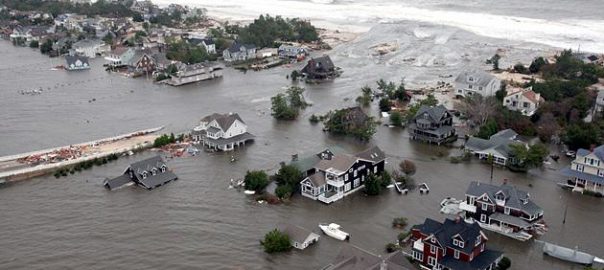
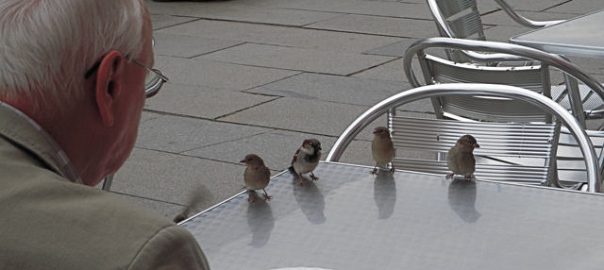
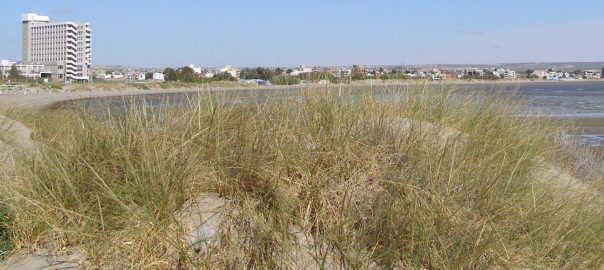


Leave a Reply